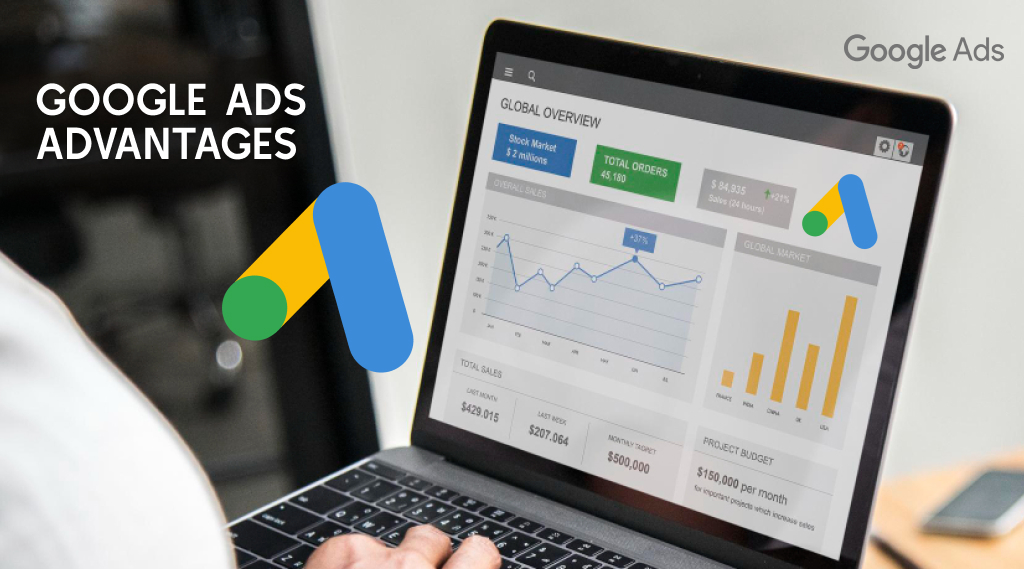Google Ads is one of the easiest and best ways to get your page, blog, and product on top of the Search Engine Results Page (SERP). It’s very easy to set up, and easy to understand for everyone. With the integration of advanced technologies like Artificial Intelligence (AI) in Google Ads, you don’t have to put in a ton of work to get things moving forward.
So, before we move on, let us shoot you with some staggering numbers. Do you know that in 2023 alone Google has gotten a whopping 237.86 billion dollars from Google Ads? This simply shows how much marketers and business people trust and use Google Ads in their marketing efforts.
So, what it is, and why you might need one? Let’s get started with the blog in detail now. So, yeah, buckle up, you’re in for a ride!
What are Google ads?
As you may already know, Google Ads, formerly known as Google AdWords, is an online advertising platform developed by Google. It uses a pay-per-click (PPC) model, where you have to pay only if a user clicks on the ad you are running. It allows businesses to create and run ads that appear on Google’s search engine results pages (SERPs) and across the vast Google Display Network. This dynamic platform operates on a pay-per-click (PPC) model, ensuring that advertisers only pay when users click on their ads.
Google Ads is more than just a platform for showcasing advertisements. It’s a comprehensive and useful tool that allows businesses to connect with their target audience at the right moment and on various online platforms. The platform’s versatility makes it suitable for businesses of all sizes and industries.
Simply put, Google Ads is the go-to platform for online advertising for many businesses looking to maximize their online visibility. In this article, we’ll discuss how well it can be utilized to maximize your business potential.
5 types of Google ads campaigns
Google Ads doesn’t just stop with search campaigns alone as some may believe. It offers much more than that. Let’s quickly summarize all of that here.
1. Search campaigns
Search campaigns target users actively searching for specific keywords on Google. These campaigns are highly effective for capturing users with high intent to purchase or engage with your business. It’ll also be effective if you’re just starting out in the business.
2. Display campaigns
Here, you can showcase visually engaging ads on websites within the Google Display Network. Display campaigns are ideal for creating brand awareness and reaching users with compelling visuals.
3. Video campaigns
This type of ad promotes video content on YouTube and across the web. Video campaigns enable your business to connect with your audience through engaging visual storytelling.
4. Shopping campaigns
Have an eStore? then this is perfect for you. Shopping campaigns highlight products with images, prices, and business details. As we said, this campaign type is essential for eCommerce businesses looking to showcase their product catalog quickly and simply.
5. App campaigns
This campaign drives app installations and engagement on various platforms. App campaigns are designed to increase app visibility and encourage users to download and interact with mobile applications.
These are all the major ad campaigns that Google has to offer. Apart from these, there are smart campaigns, discover campaigns, and so on. Understanding the unique advantages and applications of each campaign type allows your business to tailor the Google Ads strategy to align with your specific marketing goals!
10 Advantages of using Google ads
Google Ads brings a ton of benefits to the table for you. Let’s discuss this in detail now.
1. Reach a vast audience
Google is the first place everyone will end up if they’re on the lookout for a product or service. Google’s vast user base allows you to reach potential customers locally and globally. So, whether your target audience is local or international, Google Ads provides the reach needed to connect with users.
2. Targeted advertising
Displaying ads to users actively searching for products or services related to your business ensures that your marketing efforts are highly targeted. This precision in targeting helps in maximizing the impact of your advertising budget.
3. Flexible budgeting
Google Ads simply accommodates businesses with varying budget sizes. Advertisers have the flexibility to set their own budget and bid amounts, ensuring cost control and adaptability to changing needs.
4. Measurable results
The platform offers real-time analytics in Google ads itself, allowing your business to track the performance of the campaigns. Metrics such as click-through rates (CTR), conversion rates, and return on investment (ROI) provide valuable insights for continuous improvement.
5. Enhanced brand visibility
By appearing at the top of search results and on popular websites within the Google Display Network, businesses can enhance their brand visibility. Increased visibility contributes to brand recognition and trust among users.
6. Increase website traffic
Google Ads is a powerful tool for driving quality traffic to your website. Advertisements displayed in search results attract users actively seeking information, products, or services related to your business.
7. Geo-targeting
Businesses can target users based on their location, ensuring that ads are relevant to local audiences. Geo-targeting is particularly valuable for businesses with specific regional or local marketing goals.
8. Adaptability
The platform allows advertisers to quickly adjust campaign settings, keywords, and ad creatives based on performance insights. This adaptability ensures that marketing strategies stay aligned with business objectives.
9. Competitive advantage
Staying ahead of competitors is crucial in the online landscape. Google Ads provides a platform for businesses to strategically position their brand at the forefront, ensuring a competitive advantage in their industry.
10. Conversion tracking
Measuring and optimizing for specific actions, such as form submissions or purchases, is made possible through conversion tracking. This feature allows businesses to focus on actions that contribute directly to their objectives.
5 Potential disadvantages of Google ads
Not everything is beds and roses and Google Ads is no exception. While Google Ads offers numerous advantages, it’s essential to be aware of potential drawbacks too.
1. Costs can accumulate
It is true that Google Ads are affordable and cost-effective. But, over time, expenses can accumulate, especially in highly competitive industries where bidding for keywords is intense. So, you need to carefully manage the budgets to prevent unforeseen costs.
2. Learning curve
Mastery of Google Ads requires time and effort to understand the intricacies of campaign setup, management, and optimization. Businesses may need to invest in training or seek assistance from experienced professionals to navigate the learning curve effectively. Meaning, that additional costs are there potentially.
3. Competition impact
In competitive markets, bidding wars can drive up the cost-per-click (CPC) for sought-after keywords. So, again, advertisers need to carefully monitor their bidding strategies to avoid inflated costs to maintain cost-effectiveness.
4. Continuous monitoring required
Effective campaigns demand ongoing attention and adjustments to maintain optimal performance. Hence, you should continuously monitor campaign metrics, analyze data, and make strategic adjustments to ensure your campaigns remain effective.
5. Risk of click fraud
Instances of fraudulent clicks or invalid activity may occur, impacting the overall campaign budget. Implementing measures to detect and mitigate click fraud is crucial to ensure that advertising budgets are utilized effectively.
Who can use Google ads?
Google Ads is a versatile platform suitable for various business types as you might have already guessed. We’ll leave you with our suggestions here. However, the true answer depends heavily on the goals of your business.
1. Small businesses
Small businesses can leverage Google Ads to reach local customers and compete effectively with larger enterprises. The platform’s flexibility and targeting options make it accessible to businesses with varying marketing budgets.
2. eCommerce businesses
eCommerce businesses can showcase their product catalog through Shopping Campaigns, driving online sales and reaching a global audience. Google Ads provides the visibility needed to attract potential customers actively searching for products. So, if you are fairly new to this eCommerce sphere Google Ads could be it for you.
3. IT & other service providers
Business people in the service sector can promote their services and attract customers actively seeking specific solutions. Search campaigns allow businesses to capture users in need of specific services, from plumbing to IT consulting and basically everything!
4. Brands and corporations
Brands and corporations can enhance their brand visibility and engage with a broad audience. Whether the goal is to promote brand awareness or specific products, Google Ads offers the reach and targeting options needed for large-scale campaigns!
5. Local businesses
Local businesses can drive foot traffic to physical stores by targeting users in specific geographic locations. Geo-targeting ensures that ads are relevant to local audiences, making Google Ads an effective tool for local business promotion.
5 Essential things to know before using Google ads
1. Define your goals
Before you jump into Google Ads, establish clear and measurable goals that are realistic and align with your business. Whether it’s driving website traffic, increasing sales, or brand visibility, having well-defined objectives will guide your entire advertising strategy.
2. Budget strategically
Google Ads operates on a pay-per-click model, so determine a daily or monthly budget that suits your financial capacity. A well-planned budget ensures optimal results without breaking the bank.
3. Master keyword research
Conduct thorough keyword research to identify terms relevant to your audience. Choose a mix of broad and specific keywords, continually refining your list based on performance data.
4. Craft compelling ad copy
Your ad copy is your virtual sales pitch! Create compelling, concise, and relevant ad content that speaks directly to your target audience. Highlight unique selling points and include a clear call-to-action to encourage clicks. You can utilize the services of content marketing if you need any assistance.
5. Monitor and optimize
And finally! You should regularly monitor the performance of your ads by analyzing key metrics like click-through rates, conversion rates, and cost-per-click. Use these insights to optimize your strategy, allocate budget to high-performing campaigns, and refine your approach over time.
Conclusion
Google Ads stands as a potent tool for businesses aiming to elevate their online presence and achieve targeted marketing goals. In the end, it all boils down to whether you need and how well you utilize Google Ads.
Whether you’re a small business or enterprise-grade organization Google Ads can certainly help your business in the long run.


